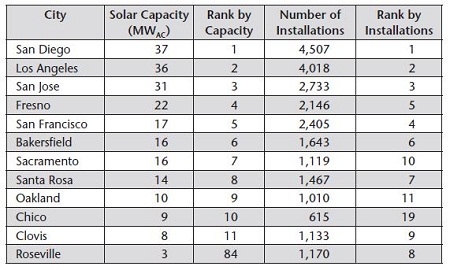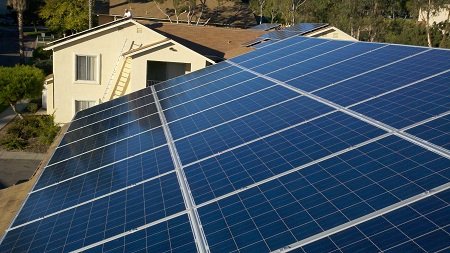Really, Los Angeles. You ought to be embarrassed. There you are, a sprawling, sun-drenched world metropolis with nearly 3.8 million residents. And yet you allow San Diego, barely a third your size with a population of 1.3 million, to beat you in solar power?
That’s the word from the Environment California Research & Policy Center, which said in a new report that San Diego has both more solar installations and more installed solar capacity than any city in California. And since California is so far ahead of the rest of the nation when it comes to turning sunlight into energy, the organization went ahead and crowned San Diego “America’s solar city.”

The Environment California report [PDF] counted all the grid-connected solar electric systems that are on or near buildings in the state. Utility-scale power plants weren’t included. And data was compiled through August 2011. At that time, San Diego had 37 megawatts (MW) of solar capacity to 36 MW for Los Angeles, and 4,507 installations compared to LA’s 4,018. What accounts for all that solar in San Diego?
“San Diego is home to the only general-market California solar rebate program administered by a non-profit organization, the California Center for Sustainable Energy, in concert with the local utility, San Diego Gas & Electric,” Environment California explained. “This program has been particularly effective in driving solar power into the residential market. Confirmed projects in its service territory add up to almost two-thirds of its residential goal under the (state’s) Million Solar Roofs Initiative—ahead of programs in the service territories of both Southern California Edison and Pacific Gas & Electric.”
As you might imagine, San Diego was pretty proud of being on top in this compilation. Various civic leaders showed up to take bows when Environment California unveiled its findings at a big event. But if you dig into the 47-page report, you see that in some ways, smaller burgs are outperforming San Diego.
For instance: Among the 10 California cities with the most solar installations, “Santa Rosa and Clovis stand out in terms of the development of their local solar markets,” the report notes. “Each of these cities has about 10 solar installations, or about 80 kW of solar capacity, for every 1,000 residents. In comparison, San Diego and Los Angeles—although they lead the pack overall—have much less developed solar markets. San Diego has about three solar installations for every 1,000 people, while Los Angeles only has one solar installation for every 1,000 residents.”

Reading the report, it’s hard not to be impressed by California’s progress in solarizing in the past decade. Consider that in 2000, California had fewer than 1,000 rooftop solar systems and less than 10 MW of solar capacity. But by 2011, it had climbed past “1,000 MW of distributed, or local, solar capacity, with more than 100,000 separate installations.” Still, the report points out that Germany—with a population just a bit more than double that of California—has 17 times the solar capacity. Even the Czech Republic, with well under a third California’s population, beats the Golden State in solar.
In the report, Environment California offers a number of policy recommendations that could help California fulfill its solar potential. A couple of the bigger ones: Adopting a strong feed-in-tariff policy to encourage solar power installation on warehouses, parking lots and other sites with low on-site energy demands but high levels of sunshine; and enhancing the value of net metering as an incentive for installing solar power.